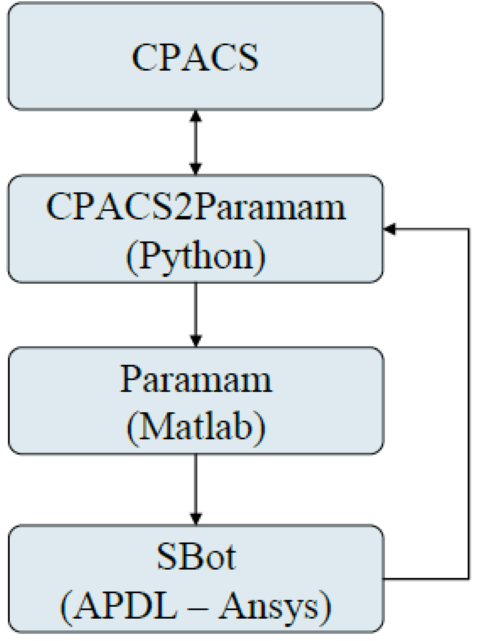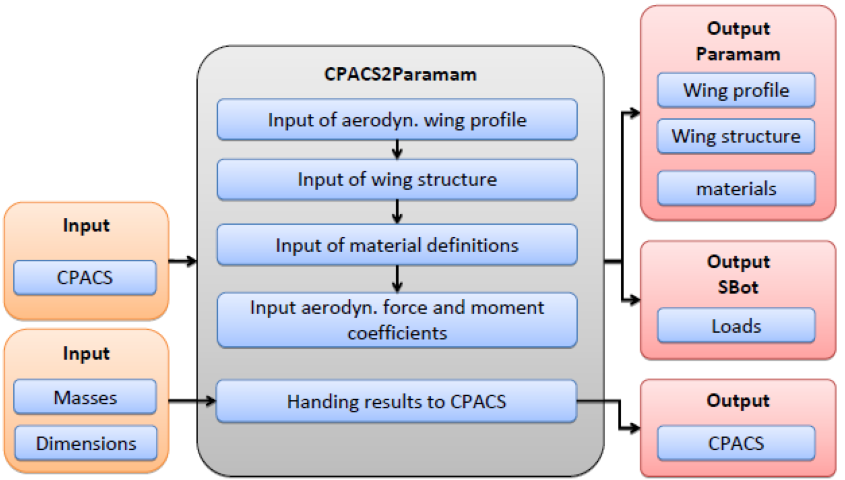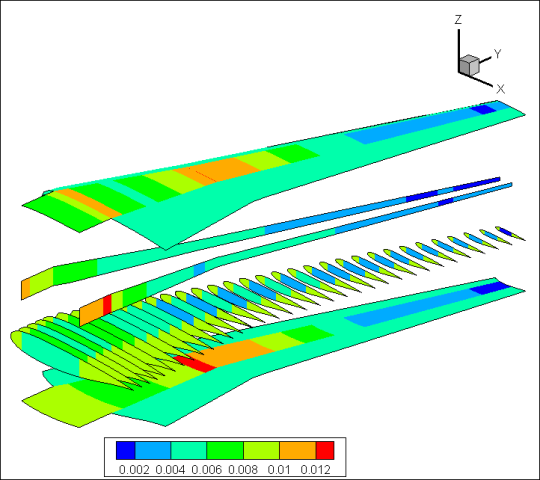| paramamSbot Element |
Due to the parametrical definition of an aircraft concept PARA_MAM/S_BOT provides flexible model generation of the structural design. PARA_MAM/S_BOT enables the user to determine stresses and strains, the resulting thickness distribution of structural components and to estimate the mass of the whole investigated structure.
Namespace: Empty
Schema: Empty
| Name | Occurrences | Description |
|---|---|---|
| | UID of the aircraft model | |
| | Tool identification |
| Name | Type | Required | Description |
|---|---|---|---|
In the following, a brief documetation of the tool PARA_MAM/SBOT will be given. The development of the previously mentioned tool is still in progress. Therefore this documentation covers the named version in the table below. The first two numbers, seperated by a dot, equals to the current available version of PARA_MAM/SBOT. The remaining numbers describe the supported CPACS version of the interface.
- Version[xx.x(PARA_MAM/SBOT Version).0.x(CPACS-Interface Version)]
V13.1.0.2
- Date
2011-05-31T17:00:00
PARA_MAM/S_BOT, like it appears within the VAMP tool chain, is a combination of two basically individual working tools (see Figure 1). PARA_MAM (PARAmetric simple and fast Mesh based Aircraft Modelling tool - for free meshes) is a parametric finite element mesh generator based on MATLAB. Within PARA_MAM ANSYS script files are created containing information about geometry, nodes, elements as well as element properties. Additionally information about optimization regions and optimization metadata is written. SBOT (Sizing roBOT) drives the optimization process by using the ANSYS FE-Solver. SBOT bases oneself on the output data of PARA_MAM. According to the input data provided by PARA_MAM a FE model is built up and iteratively analyzed. During the calculation loop reserve factors are determined and structural properties are adjusted.

Within SBOT various criteria for structural sizing are applied. They can be classified in two groups:
- Strength criteria
- Stability criteria
With respect to the material of the investigated structure the strength based criteria can be devided in an equivalent stress (van Mises) criterion and a maximum stress criterion for isotropic materials. For composite materials the criteria Puck and Tsai-Wu are implemented. Furthermore three stability criteria based on handbook methods are implemented within SBOT. One of them accounts for combined compression and bending buckling. Another one considers shear buckling. The third one is investigating a combination of the previously listed criteria. After the sizing process the resulting new thicknesses of spar web, rib web, upper/lower shell including stringers from SBOT are written back to CPACS to their original positions. Since structure definition in CPACS 1.2 doesn't provide a sufficient granularity just one thickness can be written back to CPACS per structure definition. This is about to change with CPACS 1.3. Additionally, the total wing mass and cog is written to /cpacs/vehicles/aircraft/model/analyses/massBreakdown/wings/wing/wingBoxPrimaryStructure. As illustrated in Figure 2 specific data should be provided by CPACS for running PARA_MAM/S_BOT appropriately.

In detail following data is necessary for a flawless PARA_MAM/SBOT run (consider that for reasons of simplifaction specific paths containing uID were omitted):
-
General Data
- /cpacs/toolspecific/paramamSBot,
- /cpacs/vehicles/aircraft/model[uID],
- /cpacs/vehicles/materials,
- /cpacs/vehicles/composites,
- /cpacs/vehicles/profiles/structuralProfiles,
- /cpacs/vehicles/structuralElements,
-
PARA_MAM/SBOT
- /cpacs/vehicles/aircraft/model/wings/wing/sections/section,
- /cpacs/vehicles/aircraft/model/wings/wing/segments/segment,
- /cpacs/vehicles/aircraft/model/wings/wing/positionings/positioning,
- /cpacs/vehicles/aircraft/model/analysis/loadCases/loadCase,
The following Figure exemplarily presents a resulting FE model of a wing from the current version of the tool.

A successful run of PARA_MAM/SBOT is completed by delivering an output file. This file can be found within the ReturnZip and is readable with Tecplot. The following Figure also shows only exemplarily one of the analysable results. This Figure illustrates a typical thickness distribution within a wing.
